The use of copper sulfate in gardening
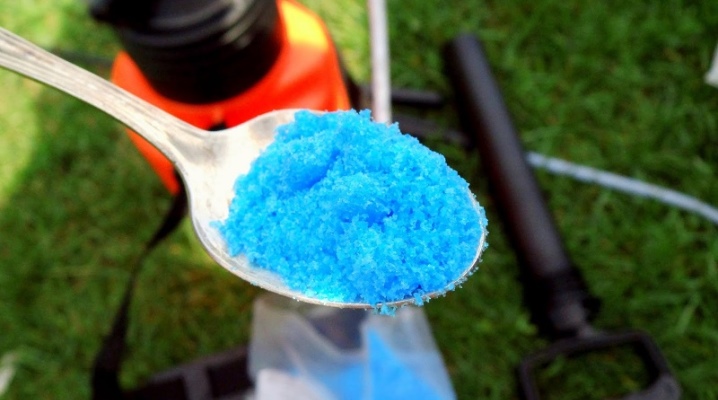
Plants grown in a summer cottage always need good care. They need not only to be watered, loosened and fed, but also protected from various diseases and pests. This is especially true during rainy seasons, when high humidity creates a good environment for bacteria and fungi. There are many remedies that can protect plants, but today we will focus on only one of them - copper sulfate.

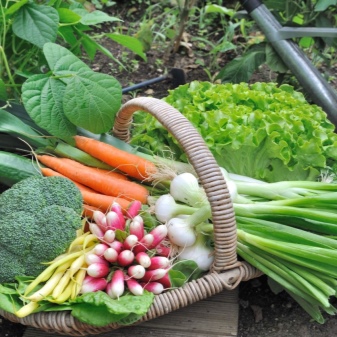
Composition and properties
Copper sulfate is a substance in demand in horticulture and horticulture, the main component of which is copper sulfate. The product looks like small crystals. The color of the drug is initially bright blue, but over time, if not used, it loses its rich shade, becoming white. Using white crystals is pointless.
We list the main characteristics of the tool:
- has a metallic taste;
- perfectly absorbed into the soil, leaves;
- dissolves well in several types of liquids;
- quickly disappears and does not smell;
- can be stored for no more than two years, provided it is completely dry.
Copper sulfate has excellent bactericidal properties, so it is used in the following cases:
- prevention of the appearance of fungal diseases;
- improving the quality of the soil;
- increasing the absorption of other nutrients by plants;
- facilitation of wintering of crops.
Nevertheless, copper sulfate belongs to the class of dangerous drugs, and if abused, it can lead to certain unpleasant consequences:
- accumulation of copper in the soil;
- poor soil permeability;
- influence on the top layer of the earth: beneficial microorganisms begin to act weakly, due to which the necessary decay processes are slowed down;
- effect on phosphorus and iron: copper displaces them, and such nutrients cannot penetrate to plants.
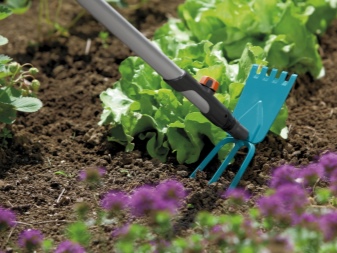
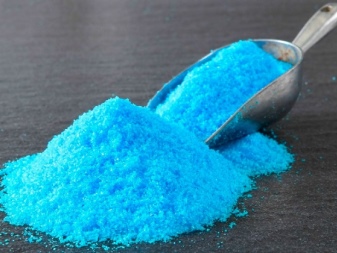
What is the difference from ferrous sulfate?
First of all, these types of vitriol differ in the main component. In iron it is iron, in copper, respectively, copper. These elements have different effects on plants and are used in different situations.
For example, ferrous sulfate is used when plants have a lack of iron, which provokes chlorosis. To prevent such an ailment, the leaves and stems of crops are sprayed with a solution of ferrous sulfate. It contains approximately 50% iron. In addition, cattle stalls are treated with a similar agent, cesspools are disinfected. The color of the crystals is green-blue.
Copper sulfate contains 24% copper, is represented by blue crystals and is used to cultivate soils with a lack of this element. Most often these are peat, sandy soils. As for the cultivated crops, they are mainly fruit trees, shrubs, berry crops, ornamental plants. Copper sulfate helps fight the fungus, as well as its pathogens.
In addition, it fights cancer and bacterial diseases, kills moss on tree trunks.

How to make a solution?
Since copper sulfate can be used for a variety of purposes, you need to figure out in advance how to prepare a solution for a particular task. There are three types of solutions in total, and each of them has a specific concentration.
- Burning out. It is the most aggressive mixture that kills proliferating microbes and mold in record time.Such a solution is called five percent, that is, it contains 500 grams of the substance, as well as a bucket of water for 10 liters. It should be remembered that after applying the burning solution, the cultivated land cannot be sown for a whole year.
- Healing. This solution has a concentration of 1-3%. Also diluted in 10 liters of liquid. Needed in the garden for processing plants in order to treat fungal diseases, as well as their prevention. It also fights pests, allows wounds on tree trunks to heal faster.
- Top dressing. The weakest solution in concentration, contains only 0.2-1% of the substance. It is used for the prevention of diseases, as well as in cases where there is not enough copper in the soil.
Regardless of the purpose for which the product is being prepared, there are several important rules for its preparation:
- dishes should be enameled or glass;
- water should be taken slightly warm;
- strain the mixture before spraying.
Now we will consider how to properly dilute the product in order to obtain the concentration necessary for various tasks.
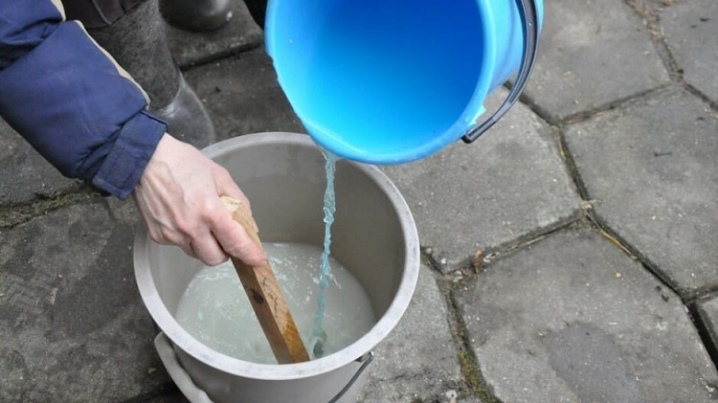
For feeding
To prepare a composition that will allow you to fertilize summer cottage crops, you must choose a concentration of no more than 1%. This concentration will help the plants get the necessary nutrition, and the solution can also be used to increase the amount of copper in the soil. One hundred grams of the substance is diluted in a liter of water. In a separate container, 150 grams of lime is stirred in the same amount of water. After that, you need to pour water into both containers, 4 liters in each, mix everything. Infuse for 15 minutes, then combine and use.
In addition, weaker solutions can be used for dressing. This is true if there is already enough copper in the soil. Then it is recommended to take 20-30 grams of vitriol and dissolve immediately in water, without lime.
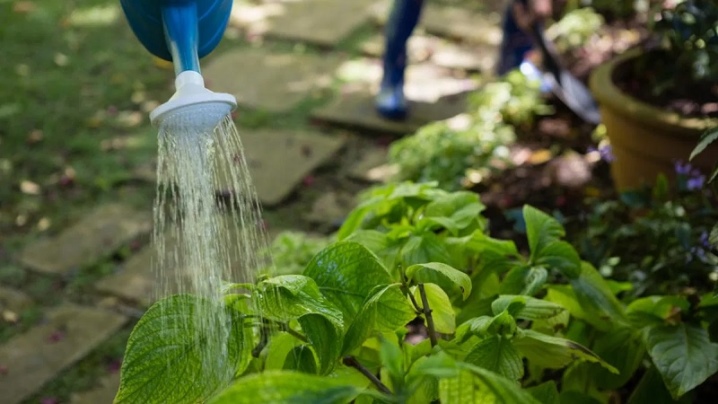
For treatment
Wet and hot weather in summer provokes the appearance of fungal pathogens. Hence the accompanying diseases: powdery mildew, fusarium, rot. In addition, pests often begin to parasitize on diseased plants. Of course, it is better to prevent the disease than to cure it, but this is not always possible. In the initial stages of diseases, a 3% solution of copper sulfate will help.
To prepare the solution, you will need 2 large containers made of glass, plastic or enameled. Crystals of vitriol (300 grams) are poured into one and poured with two liters of water. Lime (350 grams) is placed in the other and diluted with 1.5 liters of water. After that, another 5 liters of clean liquid are poured into each container. Filter the container with lime, and then slowly pour water with vitriol into it. In this case, you must not forget to stir the mixture.
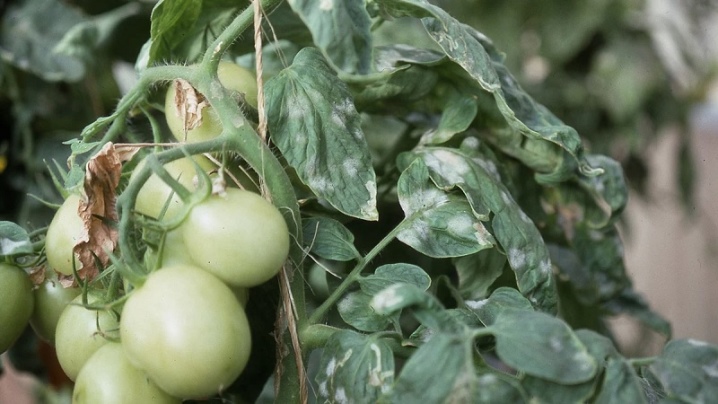
For burning out
A similar mixture is used for disinfection and disinfection of large areas. Five hundred grams of lime is diluted in half a liter of water, then the mixture is supplemented with 4 liters of liquid. In another container, vitriol is diluted in the same proportions, but in addition it needs to be poured with 5 liters. It is necessary to infuse the mixture for 30 minutes, then they are combined, slowly pouring vitriol into lime.
It is necessary to use the resulting mixture within 5 hours, then the composition will deteriorate.

For whitewashing trunks
Whitewashing wood using copper sulfate is an excellent solution, and here's why:
- trees do not get sunburn;
- the risk of cracking due to temperature changes is reduced;
- pests and pathogens can no longer penetrate the bark.
There are two good ways to prepare a tree whitewash mixture. It should be remembered that the solution, made correctly, will be thick.
- Recipe number 1. Two kilograms of lime is combined with a quarter of a kilogram of vitriol. You also need clay (1 kg) and cow dung (500 g). All this is combined and complemented by a 10 liter bucket of water.
- Recipe number 2. The same amount of lime and vitriol is taken as in the previous composition. They need to be diluted in 8 liters of liquid.Joiner's glue (250 g) is also added there.
It is important to remember that lime must be slaked. This type of drug can be bought ready-made, but it does not always have the best characteristics. Most often, experts recommend extinguishing lime at home. You need to take a kilogram of lime, as well as 2 liters of water. The drug is slowly poured into water, stirring immediately. After the lime has been slaked, it can be combined with vitriol and other ingredients.
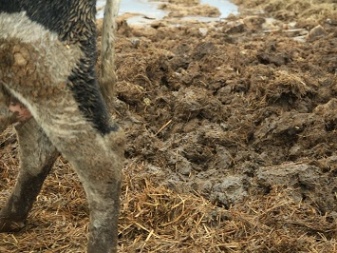
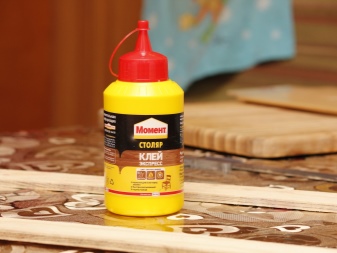
From pests
In summer cottages, not only diseases can appear, but also seasonal pests. They weaken plants, feed on them, and can destroy or damage the root system. Copper sulfate can also be used for prevention and treatment, although this is not always advisable due to the accumulation of copper. The concentration of the solution will depend on the extent to which the parasites are spread. In the initial stage, a 1% solution is enough, with an average - 3%.
If the pests are too prolific, it is better to turn to potent insecticides.
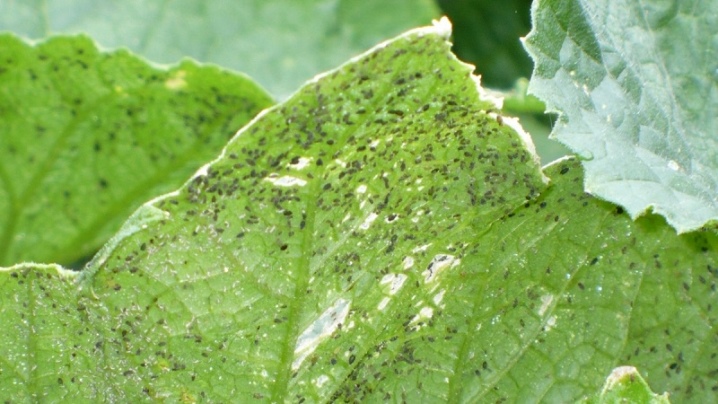
When to apply?
Copper sulfate is used in different seasons and for different purposes. NSlet's see how and when it is better to use this tool.
- Spring. During this period, a one percent solution of vitriol is used. Trees are treated with it, but only when the air has warmed up to at least +5 degrees, and the buds have not yet blossomed. The seedlings are also disinfected with such a solution: their tips are dipped into the mixture, wait 60 seconds, and then washed with water. In addition, in the spring, vitriol can be used to disinfect the soil: this should be done a month before sowing the seeds and once every 5 years. A 3% solution is best suited for this purpose. For 1 square meter, 10 liters are needed.
- Summer. In the summer, treatments are most often carried out in order to get rid of diseases and pests. Do this at a time when the fruits are formed. Trees are sprayed with a 1% solution, but if the beetle attacks, the concentration must be increased to 2%. A two percent solution is also used on berries. It is necessary to carry out processing with vitriol 3 weeks before harvesting.
- Autumn. Autumn processing will destroy fungal spores that could remain in the soil and prevent them from overwintering. The concentration of the solution will depend on the culture. Grapes, for example, need a 3% solution. Autumn treatments are carried out at sunrise or in the evening, when it gets dark. Plants are sprayed with a spray bottle and the soil is simply spilled with water.
Such treatments are necessarily carried out for winter-hardy crops before sheltering for the winter, since they create a protective layer that does not allow bacteria to pass through.

How to carry out processing?
When processing crops, you need to remember the following:
- use the resulting mixture immediately;
- it is forbidden to use iron dishes;
- personal protective equipment must come first;
- do not use the product in wet weather, with heavy gusts of wind, direct sunlight and extreme heat.
Now we will consider which areas of the summer cottage can be processed.
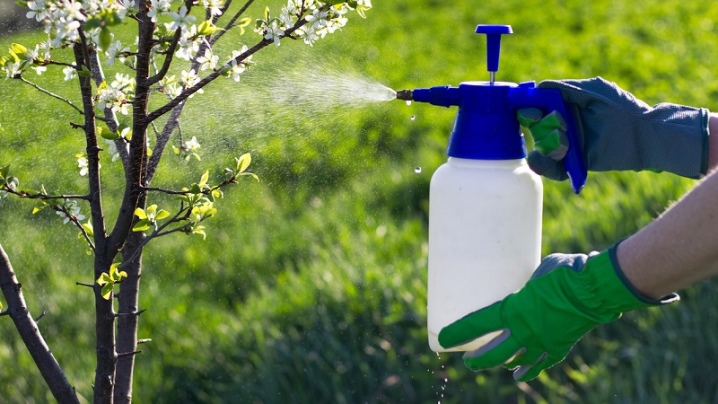
Greenhouses
Greenhouses on the site, as a rule, are processed in the fall. Cleaning instructions are as follows.
- The greenhouse is cleaned: they dig up the remains of plants, take out unnecessary pegs, sticks, twigs. All this is to be burned. After that, the structure itself is inspected, and if there are gaps in it, they must be filled with sealant.
- Dissolve 20 grams of laundry soap in a liter of water, and then clean the outer and inner surfaces with this solution. Make sure that dirty water does not run into the ground.
- In 10 liters of water, stir 400 grams of bleach. The soil is shed with this solution: a liter is required per 1 square meter.
- After that, you need to use copper sulfate. To do this, 60 grams of crystals are diluted in a ten-liter bucket of water. You will need half a liter of the mixture per square meter. After treatment, the greenhouse is washed again.
- When the treated soil is dry, it will need to be dug up.In the presence of a large number of pathogens, it is recommended to use formalin. One hundred milliliters of 40% of the product is dissolved in a 10 liter bucket of water. In advanced cases, 20 liters of funds can be spent on 1 square meter.

Of the earth
To cultivate the soil in the garden, the solution is prepared as follows:
- water is heated to a warm state - 5 liters;
- dilute 100 grams of crystals in it;
- add another 5 liters to bring the total volume to 10.
After preparation, treatment of the site follows:
- annual plants are dug up, as well as the remains of leaves, branches, sticks;
- crush large pieces of soil, carefully dig up the garden;
- a solution of copper sulfate is collected in a watering can, 2 liters should be used per square meter;
- after processing, fertilize the ground with humus.
Such treatments are preventive, they are carried out once every 5 years. If the earth is poor in copper, then a weak solution with a concentration of 0.1% should be prepared. This means that 100 grams of the substance is needed for 100 liters of water.
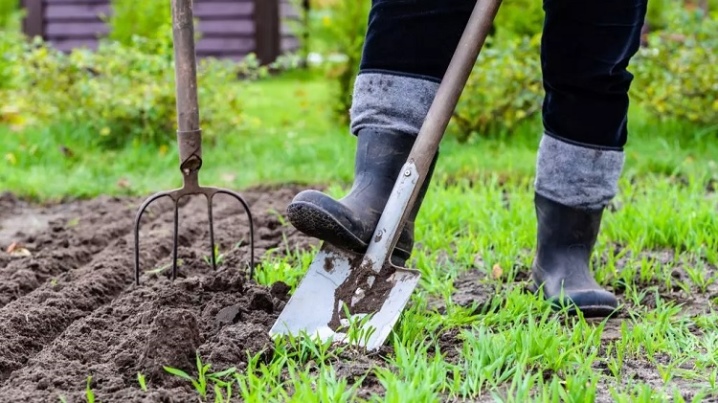
Garden plants
Copper sulfate is very often used to treat trees. This allows effective prevention and treatment, if required. Spray trees in dry weather. It should be remembered that it is necessary to process not only the soil, but also the foliage. In 10 liters of water, 100 grams of vitriol is diluted, and the treatment itself is carried out no more often than once every 3 years. Copper sulfate works well on fruit trees such as apricot, apple, pear, cherry, quince and others. TOIn addition, the proportions per square meter must be observed. For example, young crops need 2 liters, four-year-old crops need 3, plants 5-6 years old need 4 liters, and older crops need 6.
Copper sulfate has proven itself very well in the processing of grapes. This can be done at any stage of development: in early spring, during the formation of ovaries, for treatment, before wintering, and so on. Such a procedure as processing cuttings has become especially popular. Forty grams of vitriol is dissolved in a liter of water, collected in a spray bottle and sprayed on the cuttings. This will help prevent mold growth.
If wounds have formed on the grapes, a 3% solution is needed. In early spring, a solution of the same concentration is used, the treatment should be carried out right before the awakening of the vine. They do it in mid-October, before covering the grapes for the winter. Therapeutic sprays are carried out using Bordeaux liquid (vitriol with lime). Before this, it is important to inspect the grapes, and if affected parts are found, they are removed and burned. In addition, you should also dig up the soil next to the bush. During the ripening of the fruit, pure vitriol is also not used. Only Bordeaux liquid, and only a month before picking berries.
Garden flowers, including roses, can also be processed with copper sulfate. They are sprayed in the spring, in March or April, with a 1% solution of copper sulfate. The liquid should be at room temperature. Before processing the bushes, they need to be pruned.
In addition, roses need to be processed after removing the shelter. The solution is taken in the same concentration as in the middle of spring.
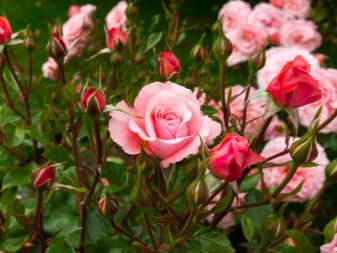

Security measures
Copper sulfate is a rather aggressive substance that can cause severe harm to health. Therefore, it is very important to properly prepare: put on a protective mask, respirator, gloves, suit. Do not allow the solution to get on the skin or into the respiratory system. This is fraught with consequences such as rash, itching, redness, weakness.
When processing crops, remember the following rules:
- there should be no people or animals near you;
- spraying is carried out on a day when there is no wind, so that the solution does not spread throughout the entire site;
- after finishing work, you need to take a shower, rinse your mouth, wash used clothes;
- if not all the product has been applied, it cannot be poured into rivers, lakes, other water areas;
- it is forbidden to process flowering and fruiting plants.
If the product nevertheless accidentally gets on the skin, you must immediately stop the treatment and wash the dermis with soap and water. The same is done in the case when the product has got into the eyes.
Accidental ingestion is much more dangerous. In this case, you need to induce vomiting (attention: it is strictly forbidden to use potassium permanganate in this case, as it will react with vitriol) and drink activated charcoal. Then it is advisable to see a doctor.



In the next video, you will find additional information on the use of copper sulfate in gardening.













The comment was sent successfully.